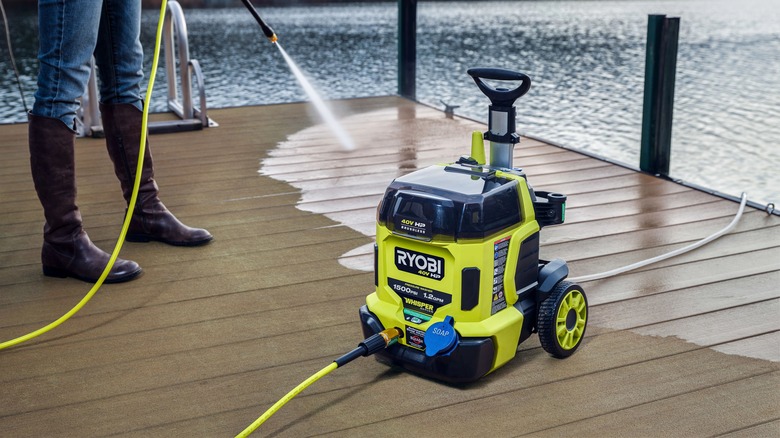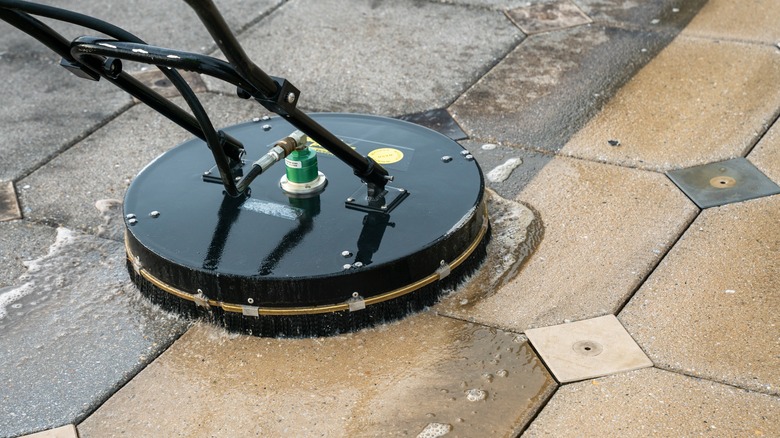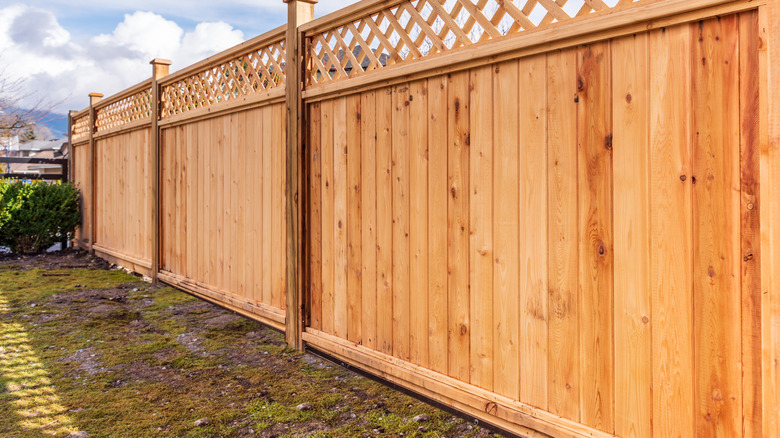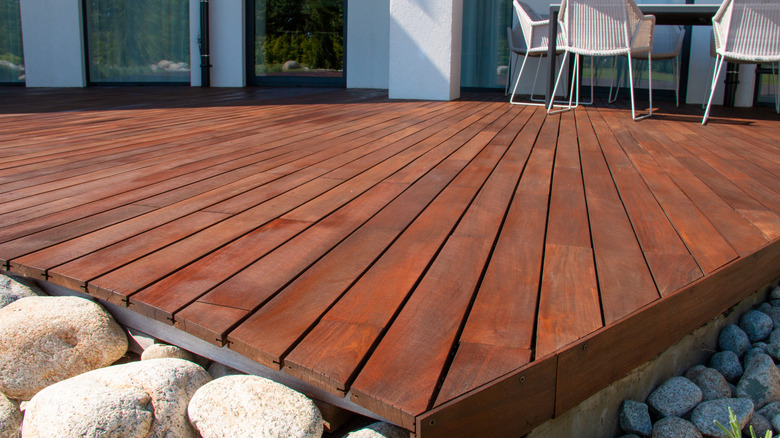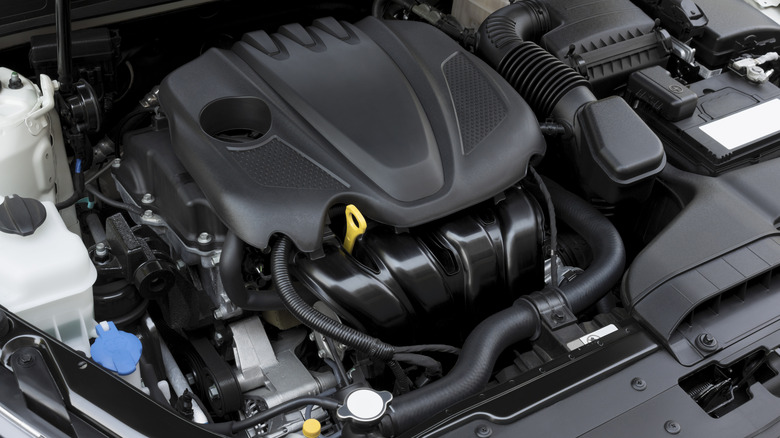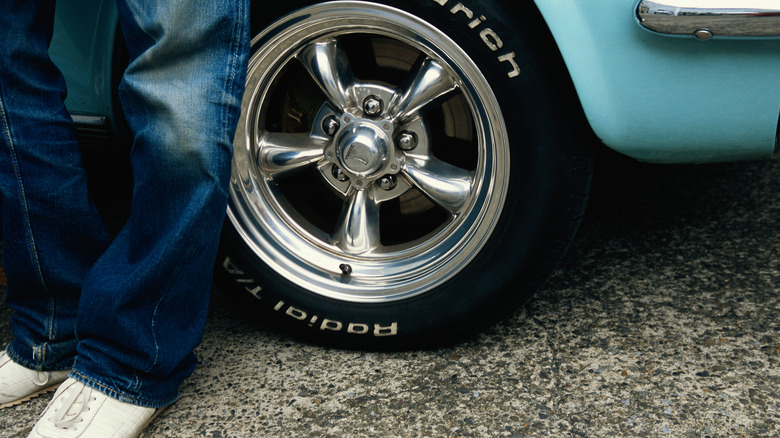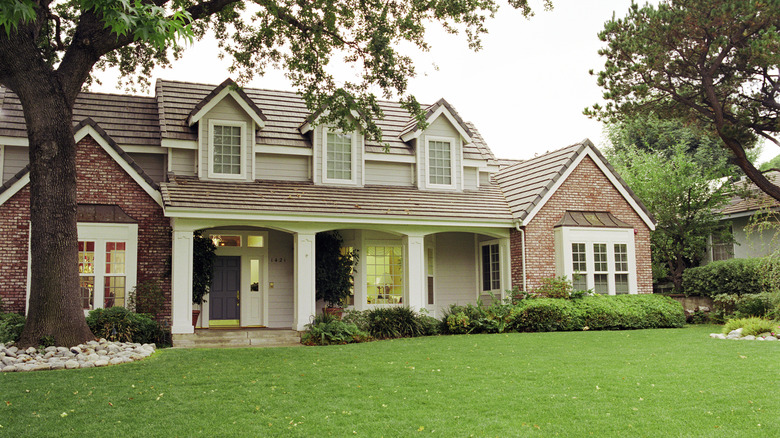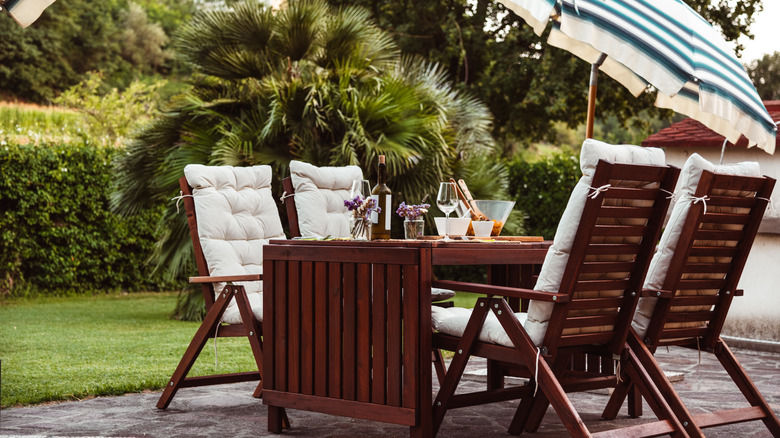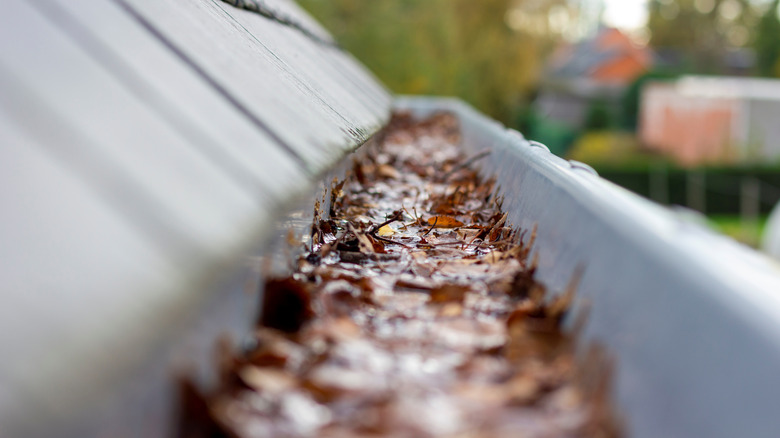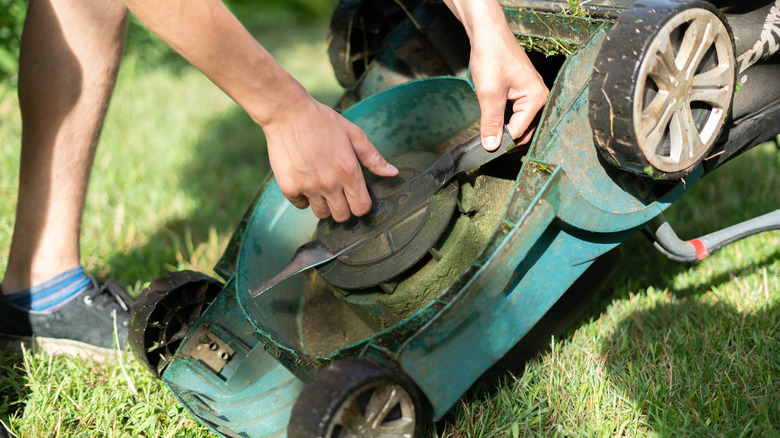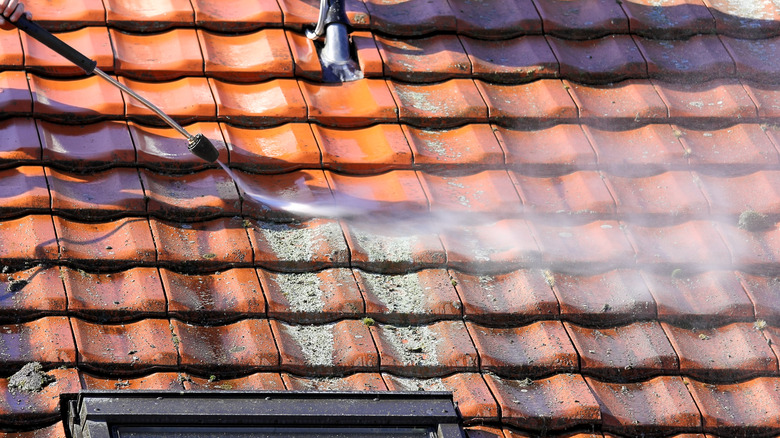Clean Or Destroy: 10 Ways To Use A Ryobi Pressure Washer Around The House
Pressure washers are some of the most fantastic tools you can have around your home, and some of the most useful Ryobi products are their pressure washers. A Ryobi tool that not only cleans surfaces but also revitalizes them, pressure washers are incredible. From driveways and patios to vehicles and outdoor furniture, a Ryobi pressure washer can clean just about anything you want it to. However, there is a right way and a wrong way to clean most things.
The intricacies of pressure washing require that you address the specific needs of different surfaces. Whether you're a seasoned pressure washer or a first-time user, it's important that you know what you're doing anytime you set out to pressure wash something around your house. Especially because some objects, when pressure washed improperly, can create hazards to yourself.
With all of that in mind, there are some things you'll undoubtedly have around to clean that will require you to do it correctly. Whether that's to avoid destroying it, or to help you clean something faster and more efficiently, you'll definitely want to know the what and the how of things to use your Ryobi pressure washer properly.
Cleaning your driveway
Your driveway, often the first impression visitors have of your home, bears the brunt of daily vehicular traffic and probably a number of oil stains. Fortunately, your Ryobi pressure washer is more than capable of breathing new life into a driveway worn down by years upon years of cars coming in and out. However, there are some things to bear in mind when setting out to clean up your driveway.
First and foremost, resist the temptation to rely solely on a standard pressure washer tip. While you aren't going to damage your driveway or anything, using a standard tip may leave you spending an eternity on what could be a time-efficient task. The key to efficiency lies in selecting the right tool for the job, and when it comes to driveways, surface cleaners are the way to go.
Surface cleaners are the unsung heroes of pressure washing, designed specifically to maximize efficiency without compromising effectiveness. These innovative attachments feature rotating nozzles housed within a protective casing, ensuring an even and thorough cleaning experience. By distributing water evenly across the surface and preventing overspray, surface cleaners dramatically reduce the time and effort required to rejuvenate your driveway.
When the time comes to clean up your driveway, putting a 2300 PSI Surface Cleaner attachment on your Ryobi Pressure Washer will help you get the job done in record time. A Turbo Nozzle attachment would also be a huge step up from your pressure washer's standard tip. Before you know it, you'll have a cleaned-up driveway and an attachment for your pressure washer that will help you clean up other similar surfaces.
Cleaning patios, fences, and decks
Patios, fences, and decks for the most part will be made up of the same kind of arrangements of boards, and you'll likely think to clean them all the same way: your pressure washer. However, for a nicer patio, fence, or deck, you'll want to be sure you're going in well prepared to avoid potentially damaging the visual appeal of these structures.
When it comes to cleaning patios, fences, and decks, power is essential. But finesse is paramount. The pressure applied should be sufficient to remove dirt and stains, yet gentle enough to avoid unintended consequences. One crucial consideration is to keep the pressure down when dealing with wooden surfaces. High pressure can strip the boards of your deck, patio, or fence, leading to unintended damage that might compromise both aesthetics and structural integrity. A 1500 PSI Ryobi pressure washer will have about the level of power that's ideal for this job.
Consistency is also key for making sure you come out with a good-looking surface. Maintain a steady distance between the pressure washer nozzle and the surface being cleaned. This ensures an even and effective clean, while minimizing the risk of inadvertently causing harm. Whether you're tackling a wooden deck, a concrete patio, or a fence, adhering to a consistent distance helps achieve a uniform result, leaving no room for unsightly streaks or uneven cleaning patterns.
Stripping paint from patios, fences, and decks
You may have been reading how to avoid stripping the paint from your patio, fence, or deck and thought to yourself, "But that's what I want!" The good news is, you can have just that. And you can still do it with your Ryobi pressure washer. Of course, there are still considerations to bear in mind if you do want to strip your patio, fence, or deck.
Whereas a simple cleaning needs you to keep the pressure down, stripping paint from your surfaces will require something a little higher. However, you'll want to avoid anything higher than 1800 PSI when cleaning wood, as you could potentially split it. High-pressure, narrow attachments are your go-to tools for this job, channeling the force of pressurized water into a concentrated stream that can effectively remove layers of paint without compromising the underlying surface.
Before you set out on your paint-stripping venture, a crucial disclaimer must be underscored: Never, under any circumstances, attempt to strip paint that is or may be lead-based. The hazards associated with lead exposure are severe, posing serious health risks, especially in residential settings. If there is any doubt about the presence of lead-based paint, it is imperative to consult with professionals and follow safe removal procedures.
Cleaning your car's engine
Something that might not immediately spring to mind when you're considering pressure washing is the engine of your car. While the idea of pressure washing under the hood may sound daunting, with the right approach, you can clean your car's engine bay with efficiency and precision. However, the golden rule here is safety first.
Most importantly, never attempt to wash the engine while it is hot. The residual heat poses a risk of rapid cooling, potentially causing damage to sensitive engine components. For optimal safety, ensure the engine has cooled down completely before initiating the pressure washing process.
Now, armed with a cooled-off engine, you'll be ready to begin cleaning. Unlike other pressure washing tasks, cleaning a car's engine requires a gentle touch. Opt for low pressure and a wide nozzle attachment to disperse water evenly over the engine bay. This not only ensures a thorough cleaning but also reduces the risk of damage to electrical components.
Maintaining a safe distance is equally crucial when pressure washing your car's engine. Stand back to avoid direct contact with the pressurized water, allowing it to dislodge dirt and grime without the risk of inadvertently causing harm. Approach the task systematically, focusing on one section at a time. Take care to cover exposed electrical components with plastic bags or waterproof coverings to prevent water intrusion. By adhering to these precautions and utilizing the gentle power of a lower-PSI Ryobi pressure washer, you'll free your engine bay from the muck of daily driving.
Cleaning your car's wheels
While you're at it with your engine, there may be something else you want to pressure wash – your car's wheels. As with many of the things around your house you can pressure wash, gentleness will prevail here. Very low pressure should be the order of the day, as the objective here is to dislodge dirt and grime without risking damage to the tire surface or the delicate sidewalls. Opt for a nozzle that produces a wide spray pattern, ensuring that the water is distributed evenly and gently across the wheel.
As you turn the pressure washer on the tires, maintain a safe distance to avoid any potential damage. The low pressure ensures that the tires receive a thorough cleaning while minimizing the risk of wearing down the rubber or causing harm to the intricate tread patterns. Work methodically, moving around each wheel to ensure all surfaces are covered and cleaned up.
Cleaning your house's exterior
The outside of your house puts up with a lot. As it quite literally weathers the elements, all sorts of dirt, grime, and muck can muss up the look of your home. Thankfully, a Ryobi pressure washer can handle this kind of cleanup.
When it comes to pressure washing your home's exterior, one size does not fit all. It all boils down to knowing the right pressure for the material you're dealing with. Concrete, brick, vinyl siding, and wood each have unique characteristics that demand a tailored approach. Stucco, for example, will require a lower 1600 PSI or preferably lower, brick should be cleaned with around 2000 PSI, and vinyl may require as high as 2700 PSI. The important thing is to look into the exact pressure to use on your home.
Before unleashing the power of pressurized water on your home's exterior, take proactive measures to protect vulnerable elements. Covering windows with plastic or waterproof materials is a simple yet crucial step. This precautionary measure shields your windows from accidental damage caused by the forceful spray of water and detergents.
As you navigate the exterior of your home, maintain a consistent distance to achieve uniform results. Keep in mind that a gradual approach often yields superior outcomes, especially when dealing with delicate surfaces. Your goal is not only to remove dirt and grime but to give your home's exterior a new shine.
Cleaning outdoor furniture
From loungers to dining sets, outdoor furniture sets endure all that comes with being outside, accumulating dirt and grime over time. While they are made to weather the elements, it still is nice to give them a good cleaning from time to time, and a Ryobi pressure washer is perfectly tooled for the task.
The key to success in this endeavor is, no surprise, using lower pressure. But this time, use the lowest of low pressure. Unlike more resilient surfaces, outdoor furniture often features delicate materials such as fabric cushions, which can be susceptible to damage under high-pressure streams. By opting for low pressure, you ensure a thorough clean without potentially shredding your outdoor seating arrangements.
Keep a safe and consistent distance from the furniture to avoid potential damage. For surfaces like metal or plastic, you can utilize a higher-pressure setting, but when it comes to fabric cushions or delicate materials, maintain a gentle touch. By employing low-pressure settings and taking a cautious approach, you'll get your furniture back to near-brand-new condition.
Removing leaves and other debris from your gutter
The efficient removal of leaves, debris, and built-up grime from your gutters is crucial for preventing potential water damage and maintaining the integrity of your home. While the task may seem daunting, your pressure washer can streamline the process, and make your gutter cleaner than it has been in a long while.
As with all pressure washer usage, your safety needs to come first here. While cleaning your gutter with a pressure washer may bring the idea of climbing upwards with your pressure washer, climbing a ladder with a pressure washer in hand poses unnecessary risks. Instead, opt for a safer alternative — a curved or long attachment designed specifically for gutter cleaning. This will allow you to extend your reach without compromising your stability, ensuring that you can clear your gutters from the safety of the ground.
When preparing to clean your gutters, start by removing any loose debris and leaves by hand. This preliminary step minimizes the risk of clogs and facilitates a more efficient cleaning process. Once the initial debris is cleared, attach the curved wand to your Ryobi Pressure Washer, adjusting the pressure settings to a moderate level. Gutter cleaning typically requires less pressure than other surfaces to avoid damage to the gutter system. With a little caution and planning, your pressure wash can take gutter maintenance from a cumbersome chore to a swift and effective task.
Cleaning your lawn mower
If you've spent a lot of time mowing lawns, you know there's one perennial issue with lawn mowers: They get absolutely disgusting, and they're not entirely easy to clean up. Thankfully, a pressure washer can expedite the process, and maybe do it a little better than you can by hand. It also gives you the opportunity to potentially wash a Ryobi lawn mower with a Ryobi pressure washer.
While working with your lawn mower, it's imperative to take a few precautionary steps. Start by disconnecting the spark plug and removing the blades. This ensures that the engine remains off during the cleaning process, minimizing the risk of accidents or damage to the internal components. The removal of the blades allows for a more thorough cleaning, reaching the nooks and crannies that accumulate grass clippings and debris.
Once the necessary precautions are in place, it's time to wield your Ryobi pressure washer with precision. Begin with a gentle rinse to remove loose debris and grass clippings from the surface of the lawn mower. Adjust the pressure settings to a lower level, especially when targeting more sensitive areas like the engine compartment or electrical components.
Moving between the different parts of your lawn mower, you need to adjust the pressure settings based on the sensitivity of each part. The engine compartment, electrical connections, and fuel tank may require a gentler touch compared to the sturdy frame or wheels. By adapting the pressure to the needs of different components, you ensure a thorough cleaning without compromising the functionality of your lawn mower.
Cleaning your roof
One final place to go with your pressure washer is up. Specifically, to your roof. Your roof endures the brunt of weathering, accumulating debris, moss, and stains over time. Cleaning your roof can make your home more energy-efficient, so it's not just aesthetics you'll be chasing here.
Some roofing materials, such as asphalt shingles, wood shingles, or slate, can be sensitive to high-pressure streams. Opt for low pressure to dislodge debris without causing damage. The goal is not just cleanliness, but the preservation of your roof's integrity and aesthetic appeal. As with cleaning your house's exterior, be sure to research the kind of pressure your roofing material should be exposed to before you start blasting.
Working high off the ground will also require you to take some additional safety precautions, such as using non-slip shoes. Additionally, you can't use an attachment to reach your roof like with the gutter. For this job, it's best to have a second person on hand to help you maintain safety throughout the job.
Before starting to clean, perform a preliminary inspection of your roof. Identify areas with moss, algae, or stains, and take note of any loose shingles. For moss-covered regions, consider applying a specialized moss killer or cleaner before pressure washing, to enhance the effectiveness of the cleaning process.
Once you've started, it's just a matter of cleaning in sections and using a wide-angle attachment. You'll also need to be cautious of vents and chimneys, as you don't want to accidentally blast water into your house. Once your roof has been thoroughly rinsed, you'll want to allow a day to pass for your roof to dry. It's very important that after your roof has dried, you check for any possible accidental damage and repair it immediately.
